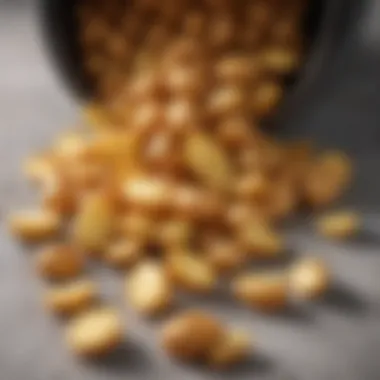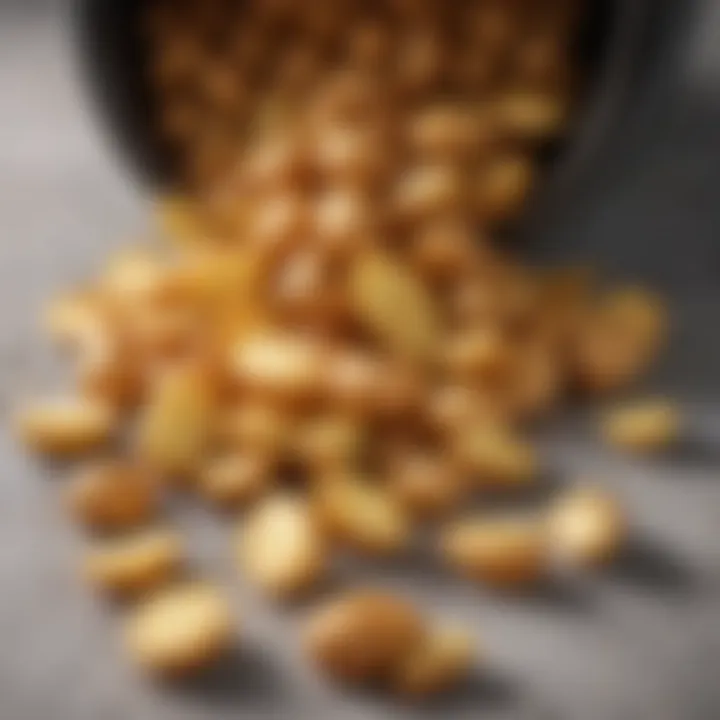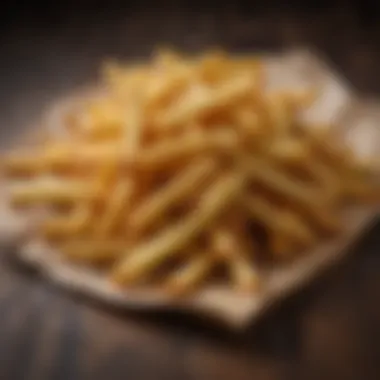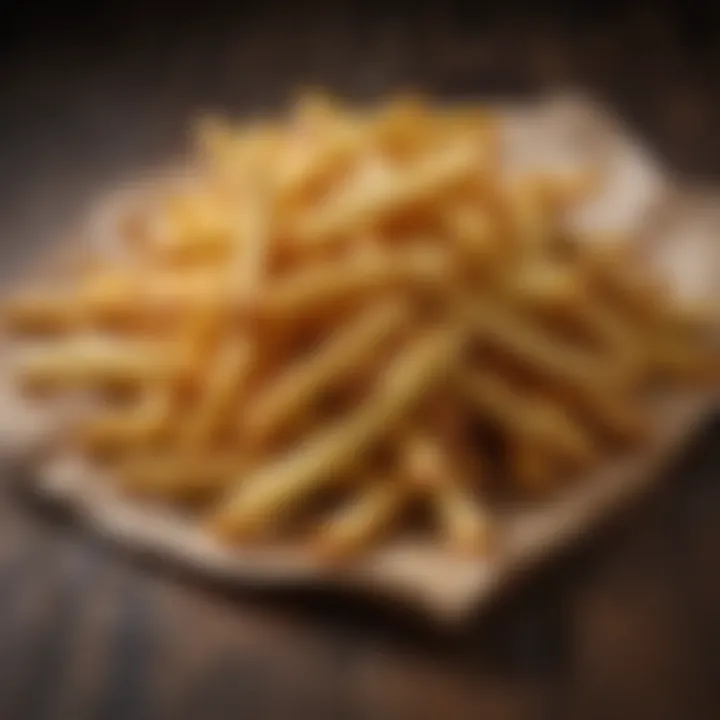Mastering Air Fryer French Fries: Timing & Techniques


Intro
Air fryer French fries have become a popular choice among food enthusiasts for their convenience and healthier attributes. This guide aims to educate readers on the art of preparing perfect air fryer French fries. From selecting the right type of potato to mastering the ideal cooking time, we will cover all aspects necessary to achieve crispy and delicious fries. This content is aimed at individuals who appreciate both efficiency in the kitchen and rich flavors in their meals.
Understanding the methods behind air frying not only simplifies cooking but also enhances the quality of the final dish. With the right techniques, you can turn a simple potato into a delightful side or snack that will impress anyone. Let’s dive deeper into this culinary adventure.
Foreword to Air Frying
Air frying represents a modern evolution in cooking technology, making it highly relevant to anyone interested in preparing delicious meals efficiently. This method offers a healthier alternative to traditional frying by using minimal oil while still achieving a crispy texture. In this article, we focus on air frying French fries, a beloved comfort food enjoyed by many.
Understanding air frying involves recognizing the appliance's ability to circulate hot air, which cooks food evenly. The essence of the air fryer lies in its ability to mimic the effect of deep frying without the excessive oil. Thus, air frying not only caters to taste but also health-conscious dining.
As we delve into the specifics of air fryer French fries, we will explore various facets, including:
- The science behind air frying.
- The beneficial aspects of using an air fryer.
- Essential techniques for achieving the perfect French fry.
By grasping the fundamentals of air frying, readers can optimize their culinary methods to enjoy flavorful dishes that align with contemporary dining habits. In a world where time and health are increasingly prioritized, the air fryer serves as a reliable ally.
What is Air Frying?
Air frying is a cooking technique that uses hot air circulation to produce crispy foods without the need for large amounts of oil. The appliance operates by rapidly circulating air around the food, promoting even browning and cooking.
Unlike deep frying, which submerges food in hot oil, air frying allows for a similar texture with significantly less fat, making it a popular choice among health-conscious individuals. The ability to prepare a variety of dishes, from appetizers to desserts, enhances its appeal. Essentially, air frying represents a harmonious blend of convenience and taste, meeting the demands of today’s fast-paced lifestyle.
Benefits of Using an Air Fryer
Using an air fryer presents numerous advantages:
- Healthier Cooking: Reduces oil consumption, leading to lower calorie dishes.
- Versatility: Capable of cooking various food types—meats, vegetables, and desserts.
- Faster Preparation: Typically cooks food quicker than traditional baking or frying methods.
- Easy Cleanup: Many air fryer components are dishwasher-safe, simplifying post-cooking maintenance.
- Temperature Control: Many models come with adjustable settings, allowing for precise cooking.
Embracing this innovative cooking method can elevate one's culinary experience while aligning with healthier choices. Understanding the basics of air frying is the first step toward mastering techniques for preparing perfect French fries.
Choosing the Right Potatoes
Selecting the right potatoes can significantly influence the quality of your air-fried French fries. The type of potato determines the texture, taste, and even the cooking time of your fries. In this section, we will explore not only the types of potatoes that work best but also the specific factors you should consider when making your choice.
Types of Potatoes Suitable for French Fries
Certain potato varieties are more suitable for making French fries than others. Here are some of the most recommended types:
- Russet Potatoes: These are the most popular choice for French fries. They have a high starch content, which leads to a fluffy interior while achieving a crispy exterior. The classic French fry experience often relies on russets.
- Yukon Gold Potatoes: With a slightly buttery flavor, Yukon Golds also work well. They have a medium starch content, producing fries that are tender inside and crispy outside, though not as fluffy as those made from russet potatoes.
- Red Potatoes: Less commonly used, red potatoes offer a waxy texture. They tend to hold their shape well but might not achieve the same level of crispiness as russet fries. They can be a good option for a different style of fry.
When choosing potatoes, russet is the standard for achieving the ideal fry texture, but experimenting with other varieties can yield interesting results.
Factors to Consider When Selecting Potatoes
Several factors play a crucial role while selecting potatoes for air-frying:
- Starch Content: High-starch potatoes, like russet, create fluffy fries. Medium-starch potatoes offer a balance, while low-starch ones hold their shape but may become gummy.
- Freshness: Fresh potatoes provide the best flavor and texture. Older potatoes can be sprouted or have green skins, which indicate they are past their prime.
- Size and Shape: Choose potatoes that are relatively uniform in size to ensure even cooking. Larger potatoes may require more time compared to smaller ones.
- Skin Condition: Look for smooth skin without blemishes or soft spots. Imperfections may suggest an inferior texture or taste.
In summary, while russets are favored for their high starch content, factors such as freshness and size also significantly affect the choice of potatoes. Keeping these considerations in mind will help you in preparing air-fried French fries that meet your standards of deliciousness.
Preparing Potatoes for Air Frying
The process of preparing potatoes for air frying is crucial for achieving crispy, flavorful French fries. Each step in this phase impacts the final product. Proper preparation ensures that the fries cook evenly, have a pleasing texture, and absorb seasonings effectively. Without adequate preparation, potatoes may turn out soggy or unevenly cooked. Thus, understanding how to wash, peel, cut, and soak is fundamental for anyone aiming to master the art of air fryer French fries.
Washing and Peeling Potatoes
Washing potatoes is an essential first step. It removes any dirt or contaminants that may affect taste and quality. Rinsing them under cold water and scrubbing with a vegetable brush should suffice. When it comes to peeling, this step depends on personal preference and the type of potato used. For instance, russet potatoes are often peeled to achieve a smoother texture, while red potatoes might be left unpeeled to enhance flavor and nutrition. Peeling potatoes can, however, remove some of the nutrients found in the skin, which is why it’s worth considering which potatoes to peel based on the desired outcome of the fries.
Cutting Techniques for Uniform Fries
Uniformity in fry size is critical for even cooking. Irregularly cut fries can lead to some being burnt while others remain undercooked. Using a sharp knife or a mandoline ensures that each fry is of consistent thickness. Aim for cuts that are about one-fourth to one-half inch thick. This size strikes a balance between cooking speed and texture. Vertical and diagonal cuts can create unique shapes and appearances, but uniform shapes will yield more consistent results. After cutting, it is advisable to place them into cold water for a few minutes to further prevent uneven cooking.
Soaking Potatoes to Improve Texture
Soaking cut potatoes is a technique that enhances the texture of the final French fries. By submerging the cut fries in cold water for at least 30 minutes, excess starch is removed. This removal is significant as it allows for a crispier outcome during air frying. Starch can cause fries to stick together and can lead to a gummy texture when cooked. After soaking, be sure to drain and pat the fries dry with a clean towel. This step is vital; moisture can hinder the frying process and lead to soggy fries. A light toss in oil afterward can also aid in achieving that desirable crispiness.
"The key to perfect French fries in an air fryer lies in the preparation of the potatoes."
Seasoning French Fries
Seasoning is a crucial aspect of preparing French fries that often goes overlooked. The choice of seasonings can define the overall flavor profile of the fries, taking them from bland to exceptional. Appropriately seasoned fries are not just about taste; they elevate the dining experience. They create a perfect balance that complements various dips and mains. Understanding how to season French fries properly is essential for anyone who desires to enhance their culinary skills.
Different seasonings can vary widely in character. Options range from classic combinations like salt and pepper to gourmet blends that include garlic powder, paprika, or even chili powder. Each seasoning offers unique flavors that can appeal to different taste buds. The ability to customize and experiment with seasonings allows cooks to cater to personal preferences or to create dishes that stand out in a crowded culinary market.
Essential Seasonings for French Fries
When it comes down to the basics, there are certain seasonings that every cook should consider when preparing French fries. These include:


- Salt: The most fundamental seasoning. A good amount can enhance the natural flavors of the potatoes.
- Black Pepper: Adds a mild spice that complements many dishes.
- Garlic Powder: Introduces a savory depth that is hard to resist.
- Paprika: Not only provides taste but also imparts a beautiful color to the fries.
- Onion Powder: A subtle sweetness can enhance overall flavor.
Using these essential seasonings in the right amounts can create a flavor foundation for your French fries. It’s essential to apply the seasonings evenly to avoid uneven flavor distribution. A simple way to do this is to toss the fries in a bowl before cooking them.
Creative Seasoning Combinations
For those looking to expand their seasoning repertoire, experimenting with creative combinations can lead to delightful discoveries. Here are some interesting blends:
- Spicy Cajun Mix: Combine cayenne pepper, paprika, and oregano for a zesty kick.
- Truffle and Parmesan: A luxurious combination that can turn regular fries into a gourmet dish. Mix truffle oil with grated parmesan for an elevated flavor.
- Sweet and Spicy: Try a blend of cinnamon and cayenne for a unique contrasting taste.
- Herb Infusion: Dried rosemary or thyme mixed with garlic powder can provide a fragrant, earthy quality.
These combinations not only amplify the flavor but also allow for variation based on dietary restrictions or flavor preferences. Consider the overall meal when choosing seasonings to ensure coherence in flavors.
"A touch of creativity can turn a standard dish into a culinary masterpiece."
Air Fryer Cooking Times
Understanding air fryer cooking times is crucial for achieving crisp, golden French fries. The right timing significantly influences texture and flavor. If cooked improperly, fries can become soggy or overcooked, detracting from their appeal. This section sheds light on general cooking times and factors that may affect them, providing essential knowledge for optimal air frying.
General Cooking Time Guidelines
Cooking times for air fryer French fries typically range from 15 to 25 minutes. Several elements can contribute to these variations, including:
- Size of potato cuts: Thinner cuts usually require less time.
- Batch size: Cooking large quantities can increase time required.
- Temperature settings: Higher temperatures can speed up the process, but may impact the final texture.
- Air fryer model: Different models have varying efficiencies.
Thinner fries often reach desired doneness in around 15 to 18 minutes, while thicker cuts can take upwards of 20 to 25 minutes. Monitoring fries as they cook is advisable, ensuring you can remove them at the perfect moment.
Factors Influencing Cooking Time
Various factors can impact the cooking time of French fries in an air fryer:
- Potato Variety: Different potatoes have distinct moisture content and starch levels. For example, russets generally yield better results than waxy potatoes.
- Preparation Method: Soaking, drying, or using oil can affect the cooking speed. Well-prepared potatoes cook faster and more evenly.
- Air Fryer Preheating: Allowing the air fryer to preheat before adding fries can lead to more consistent results. This ensures fries start cooking immediately, which impacts timing.
- Moisture Content: Fries with excess moisture will take longer to cook. A thorough drying process is vital to achieving that crisp finish.
Step-by-Step Air Frying Process
The step-by-step air frying process is essential for ensuring that your French fries turn out perfectly every time. This involves several key actions, each contributing to the overall quality and taste of the fries. Failing to follow these steps can result in soggy or unevenly cooked fries, undermining the advantages of the air fryer. This section will outline the importance of each step while providing practical guidance for achieving crispiness and flavor.
Preheating the Air Fryer
Preheating the air fryer is a crucial step that is often overlooked. When the air fryer is preheated, it reaches the desired cooking temperature before you add the fries. This ensures that the fries begin cooking immediately, which helps in achieving a crispy exterior. Waiting for the air fryer to heat up not only cuts down on cooking time but also enhances the overall texture of the fries.
- How to Preheat: Most air fryers have a preheat setting. Turn on your air fryer and set it to the desired temperature, typically around 375°F or 190°C, for French fries. Allow it to warm up for about 3 to 5 minutes.
- Considerations: If you skip this step, you may find your fries taking longer to cook. This can lead to uneven results where some fries are undercooked while others may be overdone.
Arranging Fries in the Air Fryer Basket
How you arrange the fries in the basket has a direct impact on their cooking. It is best to avoid overcrowding, as this can prevent air circulation, which is essential for even cooking. Each fry needs space to allow hot air to circulate around it, promoting crispiness.
- Layering Technique: Spread the fries in a single layer. If you have a large batch, consider frying them in multiple batches. This will ensure they cook evenly and become crispy.
- Basket Techniques: Some air fryers have a tray that can be used to separate layers. Use this if you want to cook more fries at once, but be mindful of the potential for uneven cooking.
Monitoring and Shaking the Basket
Monitoring the progress of your fries is important for achieving the perfect doneness level. Halfway through the cooking process, it is advisable to shake the basket. This help to redistribute the fries for even crisping.
- Shaking Frequency: A good rule of thumb is to shake the basket around the halfway mark of the cooking time. This encourages consistent browning.
- Checking for Doneness: Keep an eye on the fries towards the end of the cooking cycle. Depending on your air fryer, you may need to adjust the time slightly to achieve your preferred level of crispiness.
Tip: Use a timer to help you keep track of cooking times effectively. Adjust based on the air fryer model and the type of potato used.
By following these steps carefully, you can maximize the performance of your air fryer and enjoy perfectly cooked French fries that meet your expectations in both taste and texture.
Evaluating Doneness and Crispiness
Evaluating the doneness and crispiness of air-fried French fries is crucial for achieving ideal flavor and texture. Understanding when fries are perfectly cooked will help you serve mouthwatering results that appeal to all senses. The process of assessing fries extends beyond a simple glance. It incorporates visual cues and tactile feedback to ensure desirable outcomes. Knowing how to evaluate these factors can significantly elevate your cooking skills.
Visual Cues for Doneness
When it comes to air-frying French fries, visual cues play a substantial role in determining doneness. Observing the fries closely can provide insights into their readiness. Here are key visual signs to look for:
- Color: Well-cooked fries should have a golden-brown exterior. If they appear pale or undercooked, they need more time in the fryer.
- Crispness: The texture of the surface should look crisper. Bubbles or a glossy appearance may indicate they aren’t fully cooked yet.
- Shape: Fries should retain their shapes without being overly soft. If they droop, they likely remain undercooked.
Ensuring these visual markers aligns with your expectations will lead to satisfying results.
Texture Assessment
Texture assessment is another vital aspect of evaluating fries. This involves a careful touch and observation to determine cook quality. The following factors will aid in texture evaluation:
- Touch: Gently squeeze a fry between your fingers. It should feel firm but yield slightly. If it is mushy, that means it requires additional cooking.
- Bite Test: Taking a bite can reveal a lot. Unlocking the taste and texture is often the most honest way to assess. A properly cooked fry should be crispy on the outside while soft in the center.
- Sound: When you shake the basket, listen closely. A light crunching sound indicates ideal crispiness, while a dull thud signals it's not yet ready.
Evaluating doneness and crispiness involves careful observation and practice. By familiarizing yourself with these cues, you can achieve perfectly cooked fries every time.
Serving Suggestions
Serving suggestions are integral to maximizing the enjoyment of air fryer French fries. It can transform a simple dish into a remarkable culinary experience. By thoughtfully selecting accompaniments and applying creative presentation techniques, you not only enhance the flavors of the fries but also elevate the overall dining experience. Understanding the right pairings and visual appeal can entice both the palate and the eye.


Best Accompaniments for French Fries
French fries have an innate ability to complement various dishes. Here are some optimal accompaniments:
- Dipping Sauces: Ketchup remains a classic choice. However, other sauces such as garlic aioli, spicy mayo, or barbecue sauce can offer a unique touch. Consider homemade variations for a personal flavor.
- Toppings: Cheese sauce, chili, and sour cream are popular toppings that work well. Adding herbs or spices can make a simple topping into a gourmet addition.
- Pairing with Mains: Fries pair wonderfully with burgers, grilled chicken, or fish. They can add texture and flavor to these meals.
Innovative dips and pairings can cater to various dietary preferences or regional tastes. For example, tzatziki sauce or a vegan ranch dressing can attract health-conscious diners.
Presentation Tips
The way French fries are served can significantly affect their appeal. Here are some effective presentation techniques:
- Serving Vessel: Use distinctive containers like cone-shaped holders or wooden boards to serve fries. This can add a rustic charm.
- Garnishing: Fresh herbs, such as parsley or chives, can add color and freshness. Sprinkle these on top just before serving for an appealing finish.
- Layering: For something different, try layering fries with toppings in a glass container. This can showcase the ingredients and create a visually engaging dish.
Storing and Reheating Leftover Fries
Storing and reheating leftover fries is an essential aspect of maximizing the enjoyment of air-fried French fries. Proper techniques can significantly influence not just the shelf-life of the leftovers but also their taste and texture when reheated. Understanding how to store fries effectively allows you to minimize waste and enjoy that delightful crispness again on another day. After all, nobody wants to eat soggy or bland fries.
Among various factors to consider, the way you cool and store leftovers affects their quality. When fries are exposed to air, they can quickly lose their appealing texture. Therefore, using the right storage techniques helps maintain their original flavor and look.
Proper Storage Techniques
To ensure your leftover French fries stay delicious, follow these simple guidelines:
- Cool Down Quickly: After cooking, allow the fries to cool for some time but do not leave them out too long. Leaving them uncovered can lead to sogginess.
- Use Airtight Containers: Place fries in airtight containers. If you want to ensure even better preservation, vacuum seal them if possible. This reduces air exposure which maintains crispness.
- Avoid Stack: When storing fries, avoid stacking them on top of each other. This could cause them to become limp. Instead, spread them evenly in a single layer within the container.
- Refrigerate Promptly: Store covered fries in the refrigerator if you plan to eat them within a few days. Leftovers can last from 3 to 5 days in the fridge.
- Freezing for Longer Storage: For longer storage, freezing fries is a viable option. Flash freeze them by spreading them out on a baking sheet before transferring to a freezer bag. This technique helps prevent them from clumping together.
Following these practices ensures your leftover fries are safely stored, ready to be reheated into a satisfying snack.
Reheating for Optimal Crispiness
Reheating French fries properly can often pose a challenge. Unlike other foods, fries have a tendency to become rubbery or soggy. Here are key strategies to achieve that sought-after crispiness:
- Use the Air Fryer: The best method for reheating is to use an air fryer. Set the temperature to around 350°F for about 3-4 minutes. This simulates the original cooking process and helps regain that crispy texture.
- Preheat the Fryer: Always preheat the air fryer before adding the fries. This ensures even cooking and enhances the overall crispiness.
- Add a Light Coat of Oil: If fries seem dry, lightly spray them with oil before reheating. This offers that fried texture without overpowering the original taste.
- Check Frequently: Monitor the fries closely while reheating. Shaking the basket halfway through also aids in better texture and even heating.
- Avoid the Microwave: Microwaving may seem convenient, but it typically results in soggy fries. Use this method as a last resort.
By adhering to these reheating principles, you can elevate leftover fries from a mere afterthought to a delightful snack or side dish. These steps will help in preserving the essence of the air-fried experience, making each bite as enjoyable as the first.
Common Mistakes to Avoid
Mistakes can often lead to unsatisfactory results when using an air fryer. Understanding and avoiding common pitfalls is crucial for achieving perfect air fryer French fries. This section will highlight several key errors, their significance, and how avoiding them can lead to better cooking outcomes.
Overcrowding the Air Fryer
One of the principal mistakes is overcrowding the air fryer basket. When too many fries are placed in the basket, air circulation diminishes, which is vital for proper cooking. Fewer fries in the basket cook evenly, allowing heat to distribute effectively. This results in a crispier exterior and fluffier interior.
- Result of Overcrowding: Fries may end up soggy or unevenly cooked.
- Advice: Aim to cook fries in batches if you have a large quantity to prepare. Ensure there is enough space between them to allow hot air to circulate freely.
Inadequate Drying of Potatoes
After washing or soaking, frying potatoes without proper drying can introduce excess moisture. This moisture can lead to steam instead of crispiness, hindering the frying process. A fundamental step is to ensure that the fries are dry before placing them in the air fryer.
- Tip: Use a clean kitchen towel or paper towels to blot off excess moisture from your cut potatoes. This step will improve the final texture significantly.
Neglecting Temperature Settings
Many home cooks fail to adjust the air fryer temperature adequately. Each air fryer model may vary, and what works for one might not work for another. Adhering to recommended temperature guidelines ensures consistent results.
- Suggestion: Use a thermometer to check the actual cooking temperature if your air fryer allows. Generally, a temperature between 375°F and 400°F is optimal for French fries.
- Consequence of Neglect: Cooking at too low a temperature might lead to undercooked fries, while too high can result in burnt outsides and uncooked insides.
Avoiding these mistakes can help elevate your air frying skills and result in delicious, perfectly cooked French fries. By understanding the importance of space, moisture, and temperature, you can master the art of air frying.
Air Fryer Maintenance and Care
Maintaining and caring for your air fryer is crucial to its performance and longevity. Just like any kitchen appliance, regular upkeep extends its life and ensures optimal cooking results. Neglecting maintenance can lead to inefficient cooking, unwanted odors, and even issues with food safety. Investing time in proper care saves money in the long run, preventing the need for replacements before their time. Additionally, a well-maintained air fryer can consistently provide tasty, crisp fries that appeal to even the most discerning taste buds.
Cleaning the Air Fryer
Cleaning your air fryer is not just about aesthetics; it plays a vital role in maintaining its functionality. After each use, effort should be made to clean the basket and pan. Here is a simple process for effective cleaning:
- Unplug the Air Fryer: Safety first. Always ensure the appliance is unplugged before starting the cleaning process.
- Let it Cool: Allow the fryer to cool completely before handling.
- Remove Components: Take out the basket and pan as these are the parts that tend to accumulate grease and food residues.
- Wash with Soap and Water: Use warm soapy water to wash these parts. Avoid metal scrubbers as they can scratch the non-stick surface.
- Check the Heating Element: Wipe the interior with a damp cloth, paying attention to the heating element. Remove any grease or food particles.
- Dry Thoroughly: Ensure that all parts are completely dry before reassembling.
Cleaning should be done regularly, ideally after every use, to ensure an enjoyable cooking experience without any unwanted flavors transferred to the next batch of fries.
Ensuring Longevity of the Appliance
To maximize the lifespan of your air fryer, incorporate the following practices into your routine:
- Avoid Overloading: Placing too many fries at once can strain the appliance and affect cooking efficiency.
- Use Appropriate Utensils: Always use silicone or wooden utensils to prevent scratching the non-stick surface.
- Check for Wear: Regularly inspect the basket and other components for signs of wear or damage. Replace any worn parts promptly.
- Store Properly: When not in use, store the air fryer in a dry space, away from moisture and dust. If possible, keep it covered to prevent dust accumulation.
- Follow Guidelines: Refer to the manufacturer's guidelines for any specific maintenance instructions tailored to your model.
By following these care strategies, you ensure that your air fryer remains a reliable tool in your kitchen arsenal without the hassle of frequent repairs or replacements. A well-kept appliance not only delivers exceptional results but also enhances your overall cooking experience.
"Regular maintenance of kitchen appliances influences performance and improves safety."


For more details on appliance care, consider visiting resources like Wikipedia or Britannica.
Comparative Analysis of Cooking Methods
Understanding the different cooking methods available for preparing French fries is vital for both novice and experienced cooks. This section unpacks the nuances between air frying, traditional frying, and baking. Each method has unique characteristics that impact texture, flavor, and health benefits. This knowledge will help in making informed decisions tailored to personal tastes and dietary considerations.
Air Frying vs. Traditional Frying
Air frying is becoming a favored choice among health-conscious individuals. It uses rapid air circulation technology, which enables fries to achieve a crispy exterior with minimal oil. In contrast, traditional frying involves submerging potatoes in hot oil. This method results in a distinctively crispy and rich flavor profile but also adds significant calories and fats.
- Health Aspects: Air frying can reduce overall fat content by up to 75% compared to traditional frying. Less oil means fewer calories and fewer unhealthy fats.
- Texture and Flavor: While air-fried fries may not have the exact crunchiness associated with deep-fried options, they maintain a satisfying texture. Moreover, the flavor is enhanced without the greasy feeling that can sometimes accompany oil-fried products.
- Cooking Time: Air fryers often cook fries faster due to the efficient heat distribution. Traditional frying can take longer to reach the desired crispiness.
One important point to note is that traditional frying may be more suitable for certain dishes where richness is key. However, for everyday fries, air frying provides a healthy alternative without compromising much on taste.
Air Frying vs. Baking
When comparing air frying with baking, several factors come into play. Baking is often perceived as the healthier option compared to traditional frying but lacks the crispy texture that many associate with fries.
- Cooking Method: Air fryers circulate hot air, which creates an environment conducive for achieving crispity swiftly. Baking requires longer cooking times at lower temperatures, resulting in softer fries.
- Flavor Profile: Air frying can help achieve a deeper flavor through the Maillard reaction due to higher temperatures. Baking usually results in more subdued flavors unless oil is added.
- Nutritional Value: Both methods can retain more nutrients compared to deep frying. However, air frying may provide a slight advantage due to reduced cooking time with higher heat.
For those looking to master the art of cooking French fries, evaluating different methods is key to achieving the perfect balance of crispiness and health.
Nutritional Aspects of Air Fryer French Fries
Understanding the nutritional profile of air fryer French fries offers deep insight into why they are a preferred choice for many health-conscious individuals. This section will address key elements such as calorie content, fat levels, and the impact of cooking methods on overall nutrition. The switch to air frying from conventional frying can have significant implications for health and dietary choices.
Caloric Comparisons
When comparing caloric intake between traditional deep-fried and air-fried French fries, it's crucial to recognize the substantial difference. Traditional frying involves submerging potatoes in oil, resulting in a high calorie count due to the oil absorption. For instance, a serving of deep-fried French fries can have around 350-400 calories depending on portion size and preparation style. In contrast, a similar serving prepared in an air fryer generally falls between 150-200 calories.
This change in caloric intake is largely due to the minimal use of oil in air frying. A light coating of oil, often as little as one tablespoon for a batch, reduces not just calories but also unhealthy fats. The reduction in calorie density signifies that air fryer French fries are more aligned with various dietary goals, including weight management.
Healthier Alternatives and Modifications
In addition to modifying cooking techniques, several healthy alternatives and adjustments can be made to enhance the nutritional value of air fryer French fries.
- Sweet Potatoes: Substituting regular potatoes with sweet potatoes can provide additional vitamins such as vitamin A and more fiber. Sweet potatoes also have a lower glycemic index, which can be more beneficial for blood sugar levels.
- Seasoning Choices: Instead of using heavy salts or pre-made seasoning mixes, consider fresh herbs or spices. Paprika, garlic powder, or even nutritional yeast can add flavor without adding calories.
- Cooking Spray vs. Oil: Instead of pouring oil, using a cooking spray can control the amount of fat used, allowing for a lighter meal that still maintains a crispy texture.
- Baking Methods: To further align with dietary preferences, one may also consider baking potatoes, although air frying typically offers a healthier profile due to less oil usage.
Understanding nutritional elements is key for anyone looking to improve their diet while enjoying classic comfort foods.
Frequently Asked Questions
This section aims to address common queries related to air fryer French fries. Understanding these questions is essential for optimizing your cooking results. By clarifying doubts, readers can achieve the best results with their air fryer.
How Long to Cook French Fries?
Determining the correct cooking time is crucial for perfect French fries. Generally, air-frying times can vary, but a good baseline is 15 to 20 minutes at a temperature of 375°F (190°C). Thickness plays a significant role; thicker fries often need more time. You can check for doneness halfway through the cooking time.
- For thin fries, aim for about 12 to 15 minutes.
- Medium thickness requires around 15 to 18 minutes.
- For thicker cuts, allow about 18 to 22 minutes.
Remember to preheat your air fryer. This ensures that the fries have even cooking from the start.
What Can Impact Cooking Time?
Several factors can influence the cooking time of your French fries. Being aware of these can help you adjust as needed:
- Potato Type: Different varieties, such as Russet or Yukon Gold, cook differently due to their moisture and starch content.
- Thickness of the Cut: As mentioned earlier, the uniformity in cutting affects cooking efficiency. Irregular cuts might result in some pieces being overcooked while others remain undercooked.
- Air Fryer Model: Some air fryers heat differently. Always refer to the manufacturer's manual for specific guidelines related to your model.
- Batch Size: Cooking a larger batch at once can trap heat and steam, causing longer cooking times. It may be prudent to cook in smaller portions to obtain crispier fries.
Understanding these elements helps ensure you gain consistent and delicious results every time.
Adapt your cooking approach based on these considerations, and you will enjoy satisfying, crispy French fries that appeal to your palate.
The End
In this article, we have explored the intricate details of achieving the perfect air fryer French fries. Understanding the methods discussed is essential for several reasons. First, mastering the cooking time is critical. This ensures that the fries are not only cooked thoroughly but also exhibit a delightful crispiness. Proper timing makes a significant difference in texture and flavor, elevating the final dish.
Moreover, the techniques outlined, from choosing the right potatoes to the importance of soaking them, serve to enhance the quality of the fries. Each of these considerations contributes to a superior culinary experience, showcasing the versatility of air frying as a cooking method.
The nutritional aspects highlighted also underscore a vital benefit of using an air fryer—offering a healthier alternative to traditional frying methods without sacrificing taste.
"Cooking is about bringing joy to the table, and with the right approaches, air fryer French fries can bring that joy effortlessly."
Incorporating these insights while adapting them to personal preferences fosters a practical approach towards cooking. The emphasis throughout was on practicality, efficiency, and the joy of creating something delicious in the kitchen.
Recap of Key Points
To summarize the key points discussed in this guide:
- Choosing Potatoes: Selecting the right type of potato plays a crucial role in the texture and flavor of the fries.
- Preparation Techniques: Proper washing, cutting, and soaking of potatoes can significantly improve the frying process.
- Cooking Times: Understanding general cooking times as well as the factors that can influence them is essential for optimal results.
- Seasoning Options: Different seasonings can enhance or change the flavor profile of the fries, encouraging creativity.
- Storage and Reheating: Proper storage techniques ensure that leftover fries maintain their quality for later enjoyment.
Encouragement for Experimentation
As with any culinary practice, experimentation is key. The air fryer offers an exciting platform for innovation in the kitchen. Consider trying various potato types, seasoning blends, or even dipping sauces to discover diverse flavor combinations.
Don't hesitate to adjust cooking times based on your preferences or the size of the fries. Small changes can lead to different textures and tastes, allowing personalization that suits individual palates.
Understanding the basics equips you with the confidence to explore. Embrace the learning process—cooking, after all, is about exploration and enjoyment. Engage with community forums, like reddit.com, or follow cooking pages on facebook.com for more ideas and inspiration. Let your air fryer be a tool for creativity that reflects your unique taste.







